The Corsair SP (Static Pressure), AF (High Airflow) 120/140mm Fan Review
by E. Fylladitakis on November 25, 2015 8:00 AM EST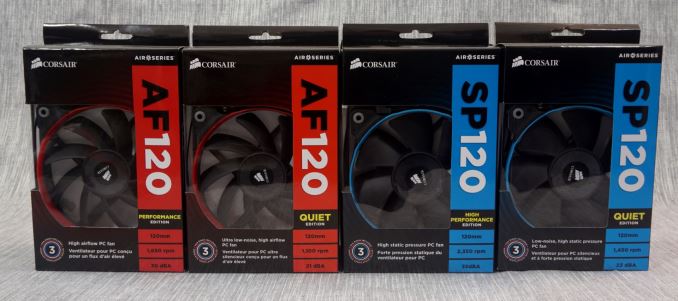
Both the selection and the testing of a fan can be a rather complicated matter. Even if someone knows the exact performance curve of a fan and can make an educated assessment regarding the airflow impedance, parameters such as the quality and noise come into play as well. Through our fan reviews, we will attempt to simplify some of these parameters and assist you with making a proper selection. Today we are looking at several of Corsair's high-end fan offerings in the 120mm and 140mm size from their SP (Static Pressure), AF (High Airflow) and LED ranges.
Introduction
As this is our first proper fan review, our primary focus is to showcase and explain the differences between different kinds of fans, as well as to begin the composing of a performance database. Corsair is our company of choice for our first review, as they offer a variety of cooling fans wide enough and designed for different applications, permitting us to easily showcase the difference between fan designs. Corsair supplied us with six different fan products, which are:
- The AF140 LED White Quiet Edition 140mm fan (High Airflow)
- The SP140 LED White 140mm fan (High Static Pressure)
- The AF120 Performance Edition 120mm fan (High Airflow)
- The SP120 Performance Edition 120mm fan (High Static Pressure)
- The AF120 Quiet Edition 120mm fan (High Airflow)
- The SP120 Quiet Edition 120mm fan (High Static Pressure)
Theoretically Corsair's offerings end up with many degrees of freedom - select AF or SP, select 120mm or 140mm, then select Performance or Quiet, the LED or no LED. This could lead up to 16 different combinations (colors of LED not withstanding), although Corsair picks and chooses so only a few of these to produce.
The Fans
We should start by immediately mentioning that the LED fan versions are not of equal design and performance as the standard versions. We will examine these differences thoroughly, but take care not to confuse the standard with the LED versions of each fan. For example, the AF140 Quiet Edition and the LED version (the AF140 LED White Quiet Edition) do share a similar product number but the non-LED version ends up having significantly better performance specifications.
The LED versions of the AF140 and the SP140 both have black plastic frames with narrowed bezels and semi-transparent blades with a "frost" texture. The wiring and the connector, as well as the provided screws, are all black.
There are four LED lights installed on the frame, in parallel with the plastic engine support bars. We received the white version of the fans but they are also available in blue, red, green and purple.
The AF140 and the SP140 side-by-side look almost identical, with the exception of the fan's blades. The high airflow AF140 has more (11) and narrow blades, capable of creating higher airflow when there is no restriction, while the SP140 has fewer (7) and wider blades, allowing it to create higher pressure and overcome airflow obstacles.
A mere look on the non-LED version of the fans is enough to reveal that they are higher performance designs than the LED versions. The plastic frame is about the same but it is of higher quality and there are hard rubber anti-vibration supports. A colored ring surrounds the intake side of the fan. By default, the SP series fans come with the blue ring and the AF series fans with the red ring installed out of the box, but all three colors (blue, red and white) are included in each package.
The Quiet and Performance versions of both the AF120 and the SP120 120 mm fans are physically identical to each other. Once again, the large differences are between the AF120 and the SP120 version fans, with the former having more and narrow blades and the latter fewer and very wide blades. However, the number, shape and angle of the blades is different than their LED counterparts, which explains their significantly different performance specifications.
Corsair advertises the SP120 and AF120 fans, both the Performance and the Quiet editions, as having a "hydraulic bearing". A hydraulic bearing technically is a sleeve bearing with the bearing and axle immersed and sealed in fluid. Technically, the axle and the sleeving do not come in contact with each other, as the fluid interferes. Unfortunately, we could not capture this in a mere picture, as the destruction of the seal and the removal of the shaft disappeared the fluid within it.
If one looks closely at the specifications of the AF140 LED and the SP140 LED fans, as well as all of the LED versions, they will notice that there is no mention of an "advanced hydraulic bearing". This is because the LED versions of the fans have an entirely different engine. When we broke the seal and removed the impeller, what we found was a self-pumping rifle bearing, which is yet another improvement of the standard sleeve bearing. What the rifle bearing does is that it uses the motion of the fan's axle itself to serve as a pump, constantly moving lubricant around the axle and the bearing. The lubricant is sealed in using a rubber seal at the top of the axle and a permanent seal at the bottom.


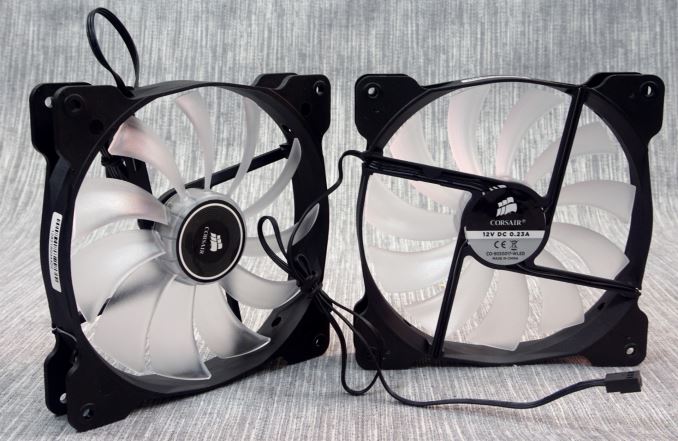

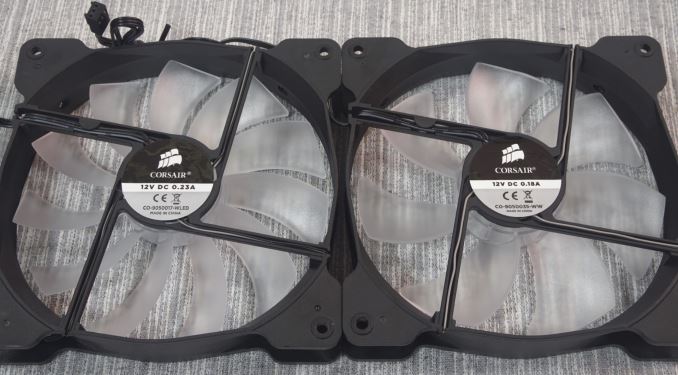
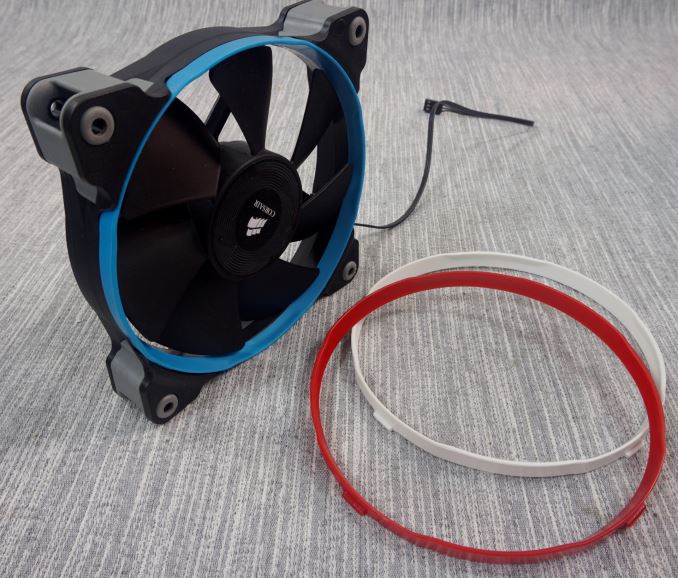

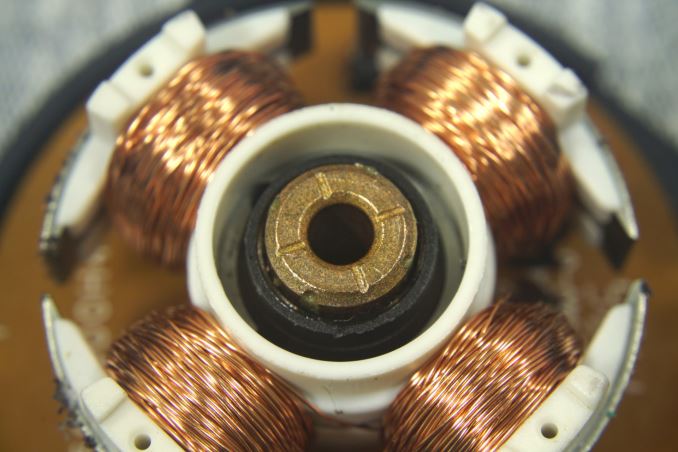
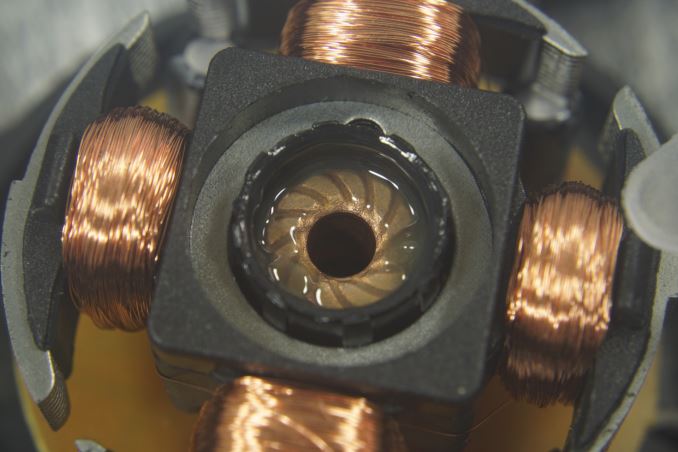
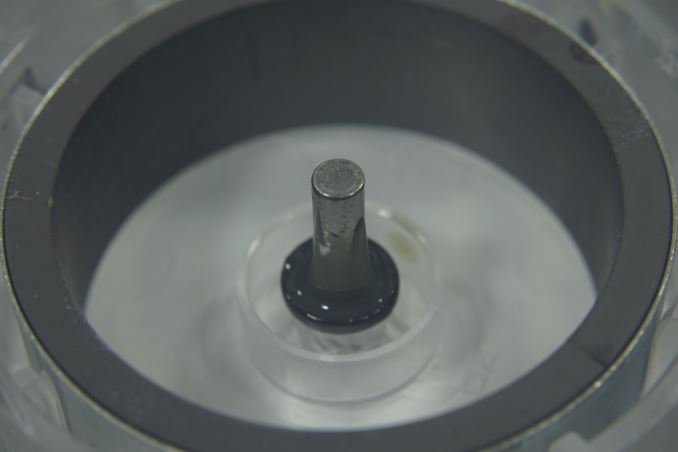








92 Comments
View All Comments
E.Fyll - Wednesday, November 25, 2015 - link
The word impedance is by no means limited to electrical resistance. Actually, electrical resistance and electrical impedance are different things to begin with.I can only assume that you are a new student if you have never heard of mechanical impedance. You definitely need to read more about it.
https://en.wikipedia.org/wiki/Mechanical_impedance
The resistance of a system to airflow is called impedance. Drag is the force that opposes airflow, generated by this impedance.
https://www.google.gr/url?sa=t&rct=j&q=&am...
Hulk - Wednesday, November 25, 2015 - link
Interesting. I have a BS in Mechanical Engineering from Rutgers and never heard the term impedance used to describe resistance to fluid flow. Not even in Fluid Mechanics where we spent about 5 weeks deriving the Navier-Stokes equations, which as you know completely describe all fluid behavior. Of course there isn't a closed form solution to these equations so complicated (real life) situations much be modeled via numerical computation.I have a feeling mechanical impedance is an older term that is rarely used anymore.
I think a much more descriptive term for this article would be to use the term "head" to quantify and describe the resistance to airflow through various computer systems as it relates to cooling. ie maintaining a certain rate of airflow though a case with a filter would have greater resistance (head) than one without a filter and thus require a different pump curve. Sizing pumps, which is what we are really talking about here is all about matching pump curves.
http://www.pricepump.com/pumpschool/psles2.html
But I think what most of us really want to know here is how much air a certain fan can move in a high head (resistance) situation and how much noise is makes, as well as in relatively low head situations. I think perhaps testing through a case with no filter would be a low head situation and though a filter would be a high head case. Perhaps testing though a relatively constrictive radiator would also be useful unless results were similar to the filter case. But once tested we'd know if both tests would be useful in the future.
Anyway, how much air flow (cooling)? How quiet? How long will it last? That's the bottom line.
Hulk - Wednesday, November 25, 2015 - link
Also I think most readers would better understand the term "head" for fluid resistance because it can be quantified as the height of a certain air column. ie pushing air case "x" with a filter is akin to pumping air an air column of "y" height, whereas removing the filter reduces the head (air column) height by z.E.Fyll - Wednesday, November 25, 2015 - link
Well, I can only assume that it depends on the school or the professor. Mechanical impedance is a very widely used term. You could run a Google Scholar search and you'd find thousands of papers published only this year.I think that I mentioned that already, but resistance and impedance are different figures. Resistance includes only Real parts. Impedance accounts for the Reactive parts as well.
Head is not resistance. Head is a measure of performance that is based on pressure. Practically, it can be converted from the left axis directly. Head = Pressure/404.3 for air, where head is in ft and pressure is in mmH20. It should generate a similar graph with a different Y axis.
Hulk - Wednesday, November 25, 2015 - link
Head is a measure of performance based on pressure and performance is exactly what you are trying to determine here. That's why I said head may be a better parameter rather than impedance. If you've worked in industry you've probably noticed no one (at least on the US East coast when it comes to pipelines or flow) talks about impedance but rather refer to "head loss." It's a working term, not a school/theory term.Oxford Guy - Thursday, November 26, 2015 - link
"It's a working term, not a school/theory term." That doesn't make it better. It just makes it common.Cold Fussion - Thursday, November 26, 2015 - link
I too have mechanical engineering degree and have never seen the term impedance used like how you use it in the fan curve graphs. Whenever I hear impedance used in a fluids context, it's normally electrical people trying to explain the resistance of a flow due to pressure. In the text books I've studied, what you describe as impedance in the curves is what would have normally described as the system curve or the system head or something along those lines.On a side note I find it pretty ridiculous that you guys have to actually do testing in order to get the fan curves instead of manufacturers providing a datasheet that has the fan curves on it (like they should be doing). I guess that shows the state of PC industry. I appreciate you guys doing real fan testing though and providing this data.
Erazor51 - Thursday, November 26, 2015 - link
E=mc2Freaky_Angelus - Friday, November 27, 2015 - link
LoL, let's throw titles as arguments...I've heard of impedance being used in fluid dynamics and, like the used mmH2O instead of Pascal, it's an older term used mainly by the 'old guard'. I would however recommend Anandtech to next time use Pa. as a term as you'll not find high tech fan-curve sheets using mmH2O (anymore).
On a side-note, if fan reviews are going to be used.. I would like to suggest a push-pull efficiency review on liquid coolers.
In the industry we almost always use pull configurations through heat exchangers as underpressure draws more evenly through an exchanger than otherwise possible with the momentum of the air. I don't have enough liquid coolers systems to be able to make a review, but my own pc is a degree lower. Considering some people might like to know these kind of things and I enjoyed to read something this close to my actual work, who knows.
Ohw, and just for bs argumentation and to be part of this thread: MSc.
mctylr - Wednesday, December 23, 2015 - link
I want to echo [Freaky Angelus]'s comments; mmH2O (millimeter of water) is a dated unit of measurement that isn't the preferred unit in any context as far as I know. It was essentially a metrication variation of inches of Mercury (inHg) that should be left to the history books. Pascals (Pa) would be the unit used for scientific literature in US and abroad. I'm not familiar with US engineering / commercial preferences for fluid dynamics and air flow/fan measurement to be sure, but I suspect they would prefer Pascals over mmH2O as well.